| Article ID | Journal | Published Year | Pages | File Type |
|---|---|---|---|---|
| 4312474 | Behavioural Brain Research | 2015 | 9 Pages |
•We assessed the development of conditioned same-sex preference in rats.•Males received a D2 agonist or oxytocin and cohabited with another male.•In a drug-free test males chose between the male and a sexually receptive female.•Conditioned preference for a male was observed with social and sexual behaviors.•Same-sex preference did not correlate with changes in sexually dimorphic nuclei.
Conditioned same-sex partner preference can develop in male rats that undergo cohabitation under the effects of quinpirole (QNP, D2 agonist). Herein, we assessed the development of conditioned same-sex social/sexual preference in males that received either nothing, saline, QNP, oxytocin (OT), or QNP + OT during cohabitation with another male (+) or single-caged (−). This resulted in the following groups: (1) Intact−, (2) Saline+, (3) QNP−, (4) OT−, (5) QNP+, (6) OT+ and (7) QNP/OT+. Cohabitation occurred during 24 h in a clean cage with a male partner that bore almond scent on the back as conditioned stimulus. This was repeated every 4 days for a total of three trials. Social and sexual preference were assessed four days after the last conditioning trial in a drug-free test in which experimental males chose between the scented familiar male and a novel sexually receptive female. Results showed that males from groups Intact−, Saline+, QNP− and OT− displayed a clear preference for the female (opposite-sex), whereas groups QNP+, OT+ and QNP/OT+ displayed socio/sexual preference for the male partner (same-sex). In Experiment 2, the brains were processed for Nissl dye and the area size of two sexually dimorphic nuclei (SDN-POA and SON) was compared between groups. Males from groups OT−, OT+ and QNP/OT+ expressed a smaller SDN-POA and groups QNP+ and QNP/OT+ expressed a larger SON. Accordingly, conditioned same-sex social/sexual partner preference can develop during cohabitation under enhanced D2 or OT activity but such preference does not depend on the area size of those sexually dimorphic nuclei.
